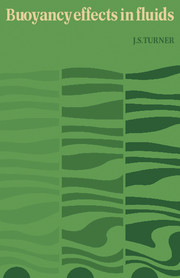Book contents
- Frontmatter
- Contents
- Preface
- 1 INTRODUCTION AND PRELIMINARIES
- 2 LINEAR INTERNAL WAVES
- 3 FINITE AMPLITUDE MOTIONS IN STABLY STRATIFIED FLUIDS
- 4 INSTABILITY AND THE PRODUCTION OF TURBULENCE
- 5 TURBULENT SHEAR FLOWS IN A STRATIFIED FLUID
- 6 BUOYANT CONVECTION FROM ISOLATED SOURCES
- 7 CONVECTION FROM HEATED SURFACES
- 8 DOUBLE-DIFFUSIVE CONVECTION
- 9 MIXING ACROSS DENSITY INTERFACES
- 10 INTERNAL MIXING PROCESSES
- Bibliography and Author Index
- Recent Publications
- Subject Index
- Plate section
8 - DOUBLE-DIFFUSIVE CONVECTION
Published online by Cambridge University Press: 05 August 2012
- Frontmatter
- Contents
- Preface
- 1 INTRODUCTION AND PRELIMINARIES
- 2 LINEAR INTERNAL WAVES
- 3 FINITE AMPLITUDE MOTIONS IN STABLY STRATIFIED FLUIDS
- 4 INSTABILITY AND THE PRODUCTION OF TURBULENCE
- 5 TURBULENT SHEAR FLOWS IN A STRATIFIED FLUID
- 6 BUOYANT CONVECTION FROM ISOLATED SOURCES
- 7 CONVECTION FROM HEATED SURFACES
- 8 DOUBLE-DIFFUSIVE CONVECTION
- 9 MIXING ACROSS DENSITY INTERFACES
- 10 INTERNAL MIXING PROCESSES
- Bibliography and Author Index
- Recent Publications
- Subject Index
- Plate section
Summary
A comparatively recent development in the field of convection has been the study of fluids in which there are gradients of two (or more) properties with different molecular diffusivities. When the concentration gradients have opposing effects on the vertical density distribution, a number of surprising things can happen, and these are the subject of the present chapter. The phenomena were first studied with an application to the ocean in mind (see §8.2.4), and because heat and salt (or some other dissolved substance) are then the relevant properties, the process has been called ‘thermohaline’ or ‘thermosolutal’ convection. Related effects have now been observed in the laboratory using a pair of solutes, and in solidifying metal alloys, and the name ‘double-diffusive convection’ has been chosen to encompass this wider range of phenomena.
The stability problem will first be reviewed, somewhat more fully than was done in previous chapters because of the comparative novelty of the double-diffusive phenomena. It will then be shown that when two components contribute to the vertical density gradient, a series of steps tends to form, with well-mixed layers separated by sharper density interfaces. The detailed structure of these interfaces and measurements of the coupled fluxes across them will also be described.
The stability problem
The mechanism, of instability
In such a system with opposing gradients, the existence of a net density distribution which decreases upwards is not a guarantee of stability.
- Type
- Chapter
- Information
- Buoyancy Effects in Fluids , pp. 251 - 287Publisher: Cambridge University PressPrint publication year: 1973
- 9
- Cited by



